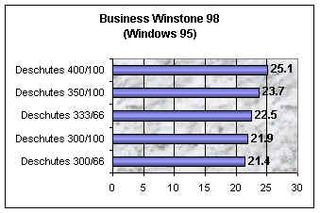Performance Preview - of Systems with Intel 440BX Chipset
The Benchmark Results
The results are not supposed to give you an absolute measure of how well systems with BX chipset will perform in comparison to systems with previous chipset models, because the tested board is pre-release and therefore the achieved results can be a lot different from what we will see when 440BX systems are final and hit the market. This test is only meant to give you some idea of how much performance gain can be expected from the raise in system clock from 66 to 100 MHz. Please also note that unfortunately I could not run the tests with more than 32 MB RAM at 100 MHz system clock, which minimizes the influence of the increase in memory bandwidth on the overall system performance even more. These results are only supposed to put an end to the old discussion if 100 MHz system bus will increase overall performance of Pentium II systems by a significant amount or not. You will see that my prediction was correct, the increase in overall performance in common applications is not much, but this is simply a mathematical equation rather than some mystical occurrence, as a lot of other people that publish about PC hardware wanted to make us believe. Intel is taking another step ahead into the next century, the impact of higher memory bandwidth may not be visible right now, but you can be sure that even in the close future computer systems will require at least 100 MHz memory clock, be sure that 200 MHz or even more will be realistic within the next 5 years.
Test System
- BX board
- Deschutes CPU
- 32 MB DIMM Samsung
- nVidia RIVA 128 AGP reference card, driver 4.10.01.0230
- Quantum3D Obsidian 100SB 4440
- IBM DAQA 33240
- Windows 95 OSR 2.1
Results

The test system with only 32 MB RAM is showing only a small performance gain in office applications by the 100 MHz system bus. The performance gain should be higher when using 64 MB RAM.

Quake II benefits by about 6%.

The performance gain of in GLQuake is a little less with about 5%.

Incoming at high resolution was supposed to show a difference due to the usage of large textures. However, the performance increase is a mere 3.5% and the frame rate doesn't seem to be depending on CPU performance at all, it's only the system bus that makes a difference.
Stay on the Cutting Edge
Join the experts who read Tom's Hardware for the inside track on enthusiast PC tech news — and have for over 25 years. We'll send breaking news and in-depth reviews of CPUs, GPUs, AI, maker hardware and more straight to your inbox.

I hoped that this test would show a larger performance increase when using 100 MHz system bus clock than the above tests. This is a little bit surprising though, since the RIVA only uses AGP 1x mode. Nevertheless is the impact of higher memory bandwidth in this test almost 8% and hence more than in any other test I performed.

3D Studio Max is heavily FPU dependent, but the calculation is purely running within the L2 cache. Hence there is practically no difference between 66 and 100 MHz system bus clock, the rendertime scales pretty much linearily.

You will certainly realize that it will take different applications to see a performance benefit of more than 5-8 % from switching from 66 to 100 MHz system bus clock in a Pentium II system. These will be applications that use large amounts of memory either directly or for caching. Data base applications as well as server environments are typical examples. There will not be that much of a difference for the normal home user though, at least not for now.
Most Popular

